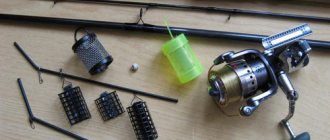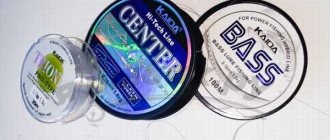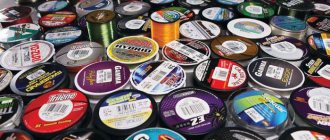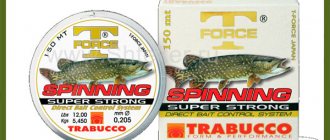Can a fish see the line? Does this affect the fish's bite? Are fish afraid of fishing line? What fishing lines should I use so that the fish are not afraid of them?
Most fishermen believe that the fish sees the fishing line, so they constantly conduct different experiments with different types of fishing line, with its colors and diameters. Marketers take advantage of this and make money from us by offering invisible fishing lines. We decided to look into this, although the information will only be our opinion, so draw your own conclusions, since no one knows what the fish actually sees.
Can a fish see the line?
We won’t go into the anatomy of fish, there is scientific literature for that, so let’s determine how a fish can see our fishing line. Fish have several sense organs, these are the eyes, ears and lateral stripe.
Fish have good hearing, quite over a wide range of frequencies, and thanks to the side band they can sense the movement and behavior of baits or prey at quite a distance. If you are interested in learning more about this, read the article: Do fish have ears?
Fish have poor eyesight, and they use it little, as this is due to the fact that the water is dark and cloudy and visibility is usually always poor.
Therefore, fish use a combination of data received from their senses, and this is a key factor when choosing fishing lines.
Do fish differentiate colors?
Scientists ichthyologists conduct research, but in fairness it must be said that not all species of fish have been examined, and some of the information is based on the personal experience of fishermen.
It has been scientifically proven that fish have color vision. Certain types of fish react sharply to color; these are mostly peaceful fish, for example, bream - a shy fish, carp, carp.
Predators don’t care about color; they are busy chasing bait and don’t pay attention to little things. But predatory fish also have very good eyesight. For example, a perch sees in muddy water much better than a human.
But whether fish are afraid of colored fishing line and how they perceive it, one can only guess.
According to reviews from many fishermen who successfully use bright colored fishing lines, fish take this fact calmly, and some colors that are bright for us literally become invisible in the water.
But there are other observations that when changing a bright fishing line to a calmer, neutral one, the fish begins to bite better, which means, probably, the color stops bothering it, it is less cautious. This cannot be attributed to any specific type of fish; it all depends on weather conditions and its mood.
The choice of fishing line is influenced not only by the color of the water in the pond, but also by the time of year. In the spring, the water is crystal clear, a riot of greenery in the summer, gives way to the colors of autumn, all these phenomena are not ignored by the fish, the color of the fishing line should also change.
Does this affect the fish's bite? Are fish afraid of fishing line?
As we can understand, the fish sees the fishing line, although not very well, hears its movement in the water and perfectly feels the vibrations that it emits.
Naturally, all this greatly affects the bite, and the fish will be afraid to approach our bait.
Perhaps this can explain the fact that in the middle of nowhere, when the bite is bad, it is enough to change the line on the fishing rod to a small diameter, for example 0.08 mm, and active biting immediately begins, since a line of such a diameter will be barely noticeable and will not make any noise. sounds.
Therefore, the fisherman’s task when choosing the necessary fishing line should be to camouflage it in the water and reduce the noise it makes. Then the fish’s bite will improve, and it will not be afraid of our bait.
We recommend: Bait for roaches: what to prepare from, what should be used in it, a universal recipe
What does the fish see?
From biologists I learned that the eye of a fish is very similar to the human eye. To detect light, fish have rod- and cone-shaped visual cells on the retina. Rods are visual receptors on the retina that function in low light. Cones are the visual receptors in the retina that function best in relatively bright light. The number of cones becomes smaller towards the periphery of the retina. Cones are less sensitive to light than rods (which support vision in low light levels) but allow color discrimination. To date, several scientific studies have been conducted on color perception in fish, thanks to which we know that most fish living in shallow freshwater bodies can distinguish colors. Color vision may vary from species to species. Unfortunately, I could not find information on color vision in pikes and muskies. In any case, the knowledge gained allowed me to draw several conclusions:
- The cleaner and clearer the water you fish in, the greater the possible choice of bait colors. Only the fish will determine which color it likes best. In bright sun, I usually start fishing with relatively dark colored lures and blue-violet colors.
- Naturally colored lures that look like real prey are a good choice in clear and shallow waters with good lighting.
- The lower the light level becomes and the deeper the fishing goes, the smaller the choice of colors becomes. Black, white and fluorescent colors come to the fore.
- Water color is also a good indicator for bait color selection. Bright blue, for example, certainly indicates that a blue lure will be successful. Coffee-colored water - brown, copper, orange. In muddy, opaque waters, the choice should be fluorescent baits.
- In low light levels, color contrast becomes more important than the perfect choice of color itself. In such conditions, you should opt for black, white and fluorescent colors.
Uli Beyer, September 2008 Translation - Dmitry Sidirov, 2009 Original text of the article Source
What fishing lines should I use so that the fish are not afraid of them?
Let's look at different types of fishing lines.
Braided lines
Braided fishing line is made from a braid containing strands of braided material, due to which it has a small diameter, high strength, it is elastic and does not stretch.
When fishing with braid, you must avoid direct proximity of the bait, fish and fishing line. To improve the stealth and camouflage of braided fishing line, you can play with its color and choose one that will not be visible in the water.
Fluorcarbon and monofilament line
According to most sellers, this fishing line is not visible in water, citing the refractive index equal to water, and other factors.
Formally, everything is so, but in reality, due to the imperfect composition of the water, deposits on the fishing line from water, algae and other factors, this fishing line is visible in the water, like a regular monofilament fishing line, but in some conditions it is really practically invisible. You can read more in this article: Fluorocarbon fishing line - myths and reality.
Mono lines are the most popular fishing lines, with their own advantages and disadvantages.
They are clearly visible in the water, they are less visible compared to braided line, but better compared to fluorcarbon line. If you play around with color selection, you can disguise it well.
Fluorocarbon
Manufacturers call fluorocarbon (or fluorocarbon) fishing line the most invisible on the market. It is said to have the same refractive index as water. Therefore, it is practically invisible, or at least it is the most invisible of the visible lines. Fluorocarbon fishing line has many properties that can please the angler. Stealth in water is the most important of these properties. This works in water regardless of its purity or clarity. With such an almost invisible fishing line, you can fish in crystal clear water and, theoretically speaking, increase the frequency of bites from especially observant fish that previously noticed the fishing line with bait. Pink fluorocarbon is especially worth highlighting. Manufacturers of this fishing line say that this shade is difficult to notice under water. And although it is difficult to believe (after all, a fisherman sees such a fishing line without difficulty), there is some truth in this. Especially when it comes to pink fishing line. Scientific studies and divers' testimonies show that the pink color fades with depth. This color fits well into the underwater picture and becomes invisible to the fish. And while the idea of painting an already invisible fluorocarbon line a shade of pink may seem unusual, the results speak for themselves: neither the angler nor the fish will see such a line underwater.
What to do and what to catch?
As we see, the fishing line needs to be camouflaged, not so much so that the fish does not see it, but so that it does not hear it.
Therefore, we offer some tips:
- The color of braided and monofilament fishing line must be chosen based on what kind of fish you catch and how it feeds, for example, if you catch fish that feeds from the bottom, then the braid should not be visible from above, and if the fish feeds from the surface of the reservoir, then from below.
- Depending on the time of day, use different colors, for example in the evening when fishing at sunset, when the sky has a red and orange tint, you should use red fishing lines, black at night, and transparent fishing lines during the day.
- When fishing, you can use fluorcarbon leashes, but how much sense this makes is a big question, at least when fishing with monofilament. It might be worth using in combination with fluorcarbon leaders. Also take into account the fact that fluorcarbon fishing lines are more rigid and it is possible that this will affect the sounds made by the fishing line, for example, when rubbing against stones, and it is not known how the fish will look at this.
We recommend: Fishing and recreation on Lake Velikoye in the Ryazan region
Unfortunately, there is no clear answer to this question; fish can see any fishing line, and there is no invisible fishing line. The choice of fishing line depends on the fishing conditions. The fisherman’s task comes down only to masking and reducing the noise made by the fishing line in the water, so the answer is to experiment.
Share link:
Monofilament line
Monofilament fishing line is the most common on the market and can be found in a wide range of colors. Manufacturers claim that almost all such fishing lines are either invisible to fish in the water or clearly visible to the fisherman above the water. Below we have analyzed the most popular colors of monofilament fishing lines and described the advantages of each.
Yellow
This highly visible fishing line is perfect for fishermen who detect bites “by eye” by the vibrations of the gear. The bright color helps you not to lose sight of the fishing line against the background of the water and helps you detect even the weakest bite. At the same time, yellow fishing line is easier for fish to notice underwater. Such a line is useful when fishing in muddy water, since in the thickness of clear water such a thread is easy to notice. But this game is worth the candle if you go after aggressive fish, which may not pay attention to the fishing line in pursuit of the bait. There is a time and place for yellow line. Often the ability to detect a bite by eye is more beneficial than reducing interest in your bait due to the caution of the prey.
Red color
They say that red fishing line is also almost invisible under water. This fact is confirmed by studies that have shown that the red color fades noticeably in the water column. On the other hand, divers claim that red shades do not so much fade as blacken. Those who use red line appreciate that it is easy to see above the water. Additional confusion is created by companies that produce red hooks. They say that such tackle attracts more fish, since red is the color of blood. Fishermen do not understand: why is the red line called invisible, and the red hooks are positioned as very noticeable? In any case, red is one option you can try if you want to change the color of your line.
Green color
The green line blends well with the water. Most bodies of water. in which it is customary to fish, they have one or another shade of green. Like camouflage, green thread camouflages well in the water column and is suitable for anglers who want to hide their line from a potential catch. At the same time, green line is more visible than transparent line in clear water. Overall, green line is a good choice for many situations.
Transparent fishing line
Clear monofilament is worth taking with you if you are going after particularly observant fish. While fluorocarbon's properties help hide line underwater, clear monofilament works well in any situation. Another color on the market is clear blue. Such a line is still invisible in the water, while it is easier to see above the water.











